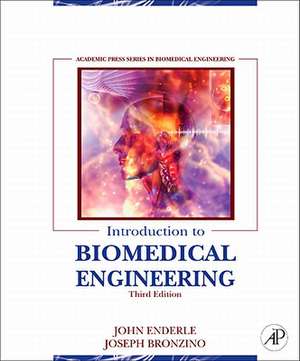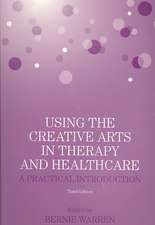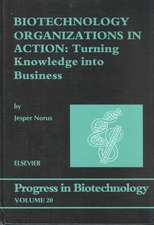Introduction to Biomedical Engineering: Biomedical Engineering
Autor John Enderle, Joseph Bronzinoen Limba Engleză Hardback – 6 noi 2020
* NEW: Image files from the text available in PowerPoint format for adopting instructors * Readers benefit from the experience and expertise of two of the most internationally renowned BME educators * Instructors benefit from a comprehensive teaching package including a fully worked solutions manual
* A complete introduction and survey of BME * NEW: new chapters on compartmental analysis, biochemical engineering, and biomedical transport phenomena
* NEW: revised and updated chapters throughout the book feature current research and developments in, for example biomaterials, tissue engineering, biosensors, physiological modeling, and biosignal processing. * NEW: more worked examples and end of chapter exercises
* NEW: Image files from the text available in PowerPoint format for adopting instructors * As with prior editions, this third edition provides a historical look at the major developments across biomedical domains and covers the fundamental principles underlying biomedical engineering analysis, modeling, and design
*bonus chapters on the web include: Rehabilitation Engineering and Assistive Technology, Genomics and Bioinformatics, and Computational Cell Biology and Complexity.
Din seria Biomedical Engineering
- 24%
 Preț: 612.86 lei
Preț: 612.86 lei - 23%
 Preț: 446.02 lei
Preț: 446.02 lei - 12%
 Preț: 623.00 lei
Preț: 623.00 lei - 23%
 Preț: 543.33 lei
Preț: 543.33 lei - 23%
 Preț: 598.82 lei
Preț: 598.82 lei - 25%
 Preț: 859.12 lei
Preț: 859.12 lei - 22%
 Preț: 359.34 lei
Preț: 359.34 lei - 25%
 Preț: 774.88 lei
Preț: 774.88 lei - 25%
 Preț: 683.18 lei
Preț: 683.18 lei - 22%
 Preț: 336.07 lei
Preț: 336.07 lei - 13%
 Preț: 309.09 lei
Preț: 309.09 lei - 13%
 Preț: 314.40 lei
Preț: 314.40 lei - 19%
 Preț: 554.48 lei
Preț: 554.48 lei - 26%
 Preț: 737.94 lei
Preț: 737.94 lei - 26%
 Preț: 711.38 lei
Preț: 711.38 lei - 26%
 Preț: 986.48 lei
Preț: 986.48 lei - 23%
 Preț: 488.83 lei
Preț: 488.83 lei - 20%
 Preț: 728.51 lei
Preț: 728.51 lei - 26%
 Preț: 1148.42 lei
Preț: 1148.42 lei - 22%
 Preț: 690.50 lei
Preț: 690.50 lei
Preț: 460.82 lei
Preț vechi: 590.85 lei
-22% Nou
88.27€ • 95.76$ • 73.55£
Carte disponibilă
Livrare economică 06-20 noiembrie
Specificații
ISBN-10: 0123749794
Pagini: 1272
Dimensiuni: 191 x 235 x 48 mm
Greutate: 2.06 kg
Ediția:3rd edition.
Editura: Elsevier
Seria Biomedical Engineering
Public țintă
Senior undergraduate and graduate level students of biomedical engineering and related courses in biological & life sciences and chemical, mechanical and electrical engineering.Cuprins
1. Biomedical Engineering: A Historical Perspective
2. Moral and Ethical Issues
3. Anatomy and Physiology
4. Biomechanics
5. Biomaterials
6. Tissue Engineering
7. Compartmental Modeling
8. Biochemical Reactions and Enzyme Kinetics
9. Bioinstrumentation
10. Biomedical Sensors
11. Biosignal Processing
12. Bioelectric Phenomena
13. Physiological Modeling
14. Biomedical Transport Processes
15. Radiation Imaging
16. Medical Imaging
17. Biomedical Optics and Lasers
Descriere
Introduction to Biomedical Engineering is a comprehensive survey text for biomedical engineering courses. It is the most widely adopted text across the BME course spectrum, valued by instructors and students alike for its authority, clarity and encyclopedic coverage in a single volume. Biomedical engineers need to understand the wide range of topics that are covered in this text, including basic mathematical modeling; anatomy and physiology; electrical engineering, signal processing and instrumentation; biomechanics; biomaterials science and tissue engineering; and medical and engineering ethics. Enderle and Bronzino tackle these core topics at a level appropriate for senior undergraduate students and graduate students who are majoring in BME, or studying it as a combined course with a related engineering, biology or life science, or medical/pre-medical course. * NEW: Each chapter in the 3rd Edition is revised and updated, with new chapters and materials on compartmental analysis, biochemical engineering, transport phenomena, physiological modeling and tissue engineering. Chapters on peripheral topics have been removed and made avaialblw online, including optics and computational cell biology. * NEW: many new worked examples within chapters * NEW: more end of chapter exercises, homework problems
* NEW: Image files from the text available in PowerPoint format for adopting instructors * Readers benefit from the experience and expertise of two of the most internationally renowned BME educators * Instructors benefit from a comprehensive teaching package including a fully worked solutions manual
* A complete introduction and survey of BME * NEW: new chapters on compartmental analysis, biochemical engineering, and biomedical transport phenomena
* NEW: revised and updated chapters throughout the book feature current research and developments in, for example biomaterials, tissue engineering, biosensors, physiological modeling, and biosignal processing. * NEW: more worked examples and end of chapter exercises
* NEW: Image files from the text available in PowerPoint format for adopting instructors * As with prior editions, this third edition provides a historical look at the major developments across biomedical domains and covers the fundamental principles underlying biomedical engineering analysis, modeling, and design
*bonus chapters on the web include: Rehabilitation Engineering and Assistive Technology, Genomics and Bioinformatics, and Computational Cell Biology and Complexity.
















